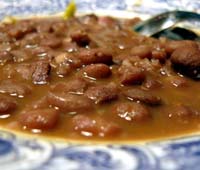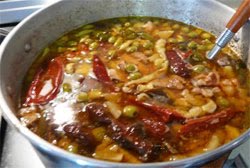
Origin: Castilla y León, Burgos

Olla podrida in Spanish means rotten pot. We know it's not a very tasty name, but the dish that carries it is. Olla Podrida is an excellent example of Spanish food: chickpeas, meat (specially pork) and lots of flavor.
According to some versions, it's rather curious name was intended as olla poderida (which would mean powerful), either because of its ingredients or because in the past only rich people could afford it. However another theory says that the name comes from its very slow cooking on the fire, so slow in fact that the products obtain a very soft texture.
It's originally from Burgos (Castilla y León) and it's cousin of cocido madrileño.
There are many stews in Spain that receive the name of "olla" (pot) or cocido (cooked), though it refers to the same. Traditionally ollas were cooked very slowly in large pots, and their characteristic is the variety of ingredients: legumes, vegetables and meat, and olla podrida is its best representative, it was even called the princess of ollas during the Spanish golden age and it was elevated to the category of symbol of the Spanish cuisine by many writers such as Cervantes and Lope de Vega and is even mention by Don Quixote.During the second half of the 19th century olla podrida was almost extinguished in Spain, but France had already inherited it when Queen Anne of Austria (consort of Louis XIII) brought it to the French courts tables.
Olla podrida's name changed to "pot-pourrí" which is the current word for dried plants and flowers all mixed together as air freshener. Nowadays the dish has reappeared and it's easy to find, specially in Burgos and surroundings towns.
Olla podrida is mostly consumed during the winter due to its high caloric content. We recommend you ask the locals for the best olla podrida in town.

Ingredients (10 portions):
*Most of these ingredients are dispensable.
Preparation: